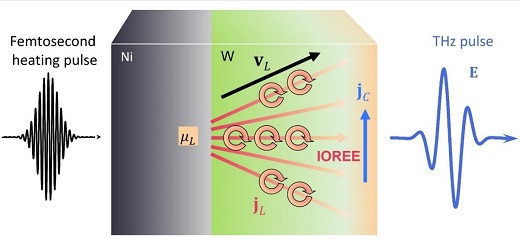by Free University of Berlin

Optically-triggered terahertz orbital angular momentum currents. Upon ultrafast laser excitation of the nickel (Ni) layer, an excess of the Ni magnetization arises, leading to an accumulation ¦Ě_L of orbital angular momentum and the injection of an orbital current j_L into the tungsten (W) layer. At the back surface, an interfacial orbital-to-charge conversion mechanismˇŞthe inverse orbital Rashba Edelstein effect (IOREE)ˇŞgenerates an ultrafast in-plane charge current j_C that emits a terahertz electromagnetic pulse with electric-field amplitude E. Credit: Tom S. Seifert
Orbitronics is a recently emerging field of research on the manipulation of the orbital degree of freedom of electrons for quantum information technology. However, unambiguously detecting ultrafast dynamics of orbital angular momentum has been challenging so far.
By using state-of-the-art THz spectroscopy, scientists from Freie Universität Berlin together with national and international partners clarified ultrafast and long-range flow of orbitally polarized electron for the first time. The research is published in the journal Nature Nanotechnology.
Surprisingly, the results show that the information stored in the orbital degrees of freedom prevails for periods about 100 times longer than the information stored in the electron's second angular-momentum channelˇŞthe spin degree of freedom. The discovery marks a significant step toward data processing with THz rates and low energy dissipation in orbitronic devices.
A time-domain observation of orbital angular momentum currents
"Our method of generating and measuring orbital angular momentum currents enables a direct time-domain observation of their propagation and relaxation dynamics with femtosecond resolution," says Tom S. Seifert, first author of the study and project leader in the Terahertz Physics Research Group at the Freie Universität Berlin, which spearheaded the study.
In their work, the researchers used femtosecond laser pulses to excite ultrafast orbital angular momentum currents in Ni|W thin-film stacks and measured the emitted terahertz electromagnetic pulses. This information allowed them to reconstruct the flow of the orbital angular momentum through tungsten as a function of time with femtosecond precision.
"We found that orbital angular momentum currents in tungsten travel at low speeds but reach very far," says Dongwook Go, second author of the study and theoretical physicist at the Peter-Gr¨ąnberg-Institute in J¨ąlich. Such unexpected behavior was also reproduced by ab-initio simulations that revealed the crucial role of the tungsten back surface for efficient orbital-to-charge-current conversion.
Disentangling spin and orbital transport on the fly
This study highlights the power of broadband terahertz emission spectroscopy in disentangling spin and orbital angular momentum transport as well as Hall-like and Rashba¨CEdelstein-like conversion processes based on their different dynamics.
Seifert and coworkers find that Ni is a good orbital angular momentum source, whereas W is a good orbital-to-charge converter. These results are a significant step toward the identification of ideal sources and detectors of orbital angular momentum currents, which will strongly benefit from accurate theoretical predictions.
"On the long run, terahertz currents of orbital angular momentum could enable ultrafast and low-dissipation data processing, a long-standing goal for future technology," says Tom S. Seifert.

